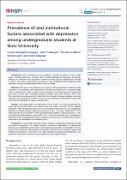| dc.description.abstract | Background: Many institutional factors predispose University students to mental health
issues, including depression. However, with no central database for depression in Uganda,
literature on depression and associated institutional factors among undergraduate students
is scarce. This study examined the prevalence of and institutional factors associated with
depression among undergraduate students at Gulu University.
Methods: This was a cross-sectional survey among 452 undergraduate students at Gulu
University in the academic year 2018/2019 in February and March 2019. A stratifi ed simple
random sampling was used to identify the participants. A self-administered questionnaire
was used to collect data. Descriptive statistics, including mean and frequency, were used.
We conducted a bivariate analysis to determine the association between variables employing
Pearson’s chi-square test or Fischer’s exact test. We conducted a multivariate analysis with
factors that had signifi cant P-values of less than 0.05.
Results: The average age of the respondents was 22.4 (SD - 2.4), more than half (53.1%)
were male and 38.50% were in the second year. The results show that 31.19% reported
depression. After controlling for age and sex, the results showed that there was a statistically
signifi cant correlation between depression and faculty (aOR - 1.15), year of study (aOR - 0.77),
happiness with the course (aOR - 0-0.49), satisfaction with academic performance (aOR - 0.45),
and satisfaction with academic quality (aOR - 0.61). The results indicated that the predictors of
depression among undergraduate students were faculty, year of study, satisfaction with academic
performance, and satisfaction with academic quality.
Conclusion: A substantial proportion of Gulu University undergraduate students reported
high levels of depression. The results, therefore, showed that depression in undergraduate
students is an identifi able disorder that needs diagnosis, prevention, and treatment. Faculty,
year of study, satisfaction with academic performance, satisfaction with academic quality were
predictors of depression. Thus there is an urgent need for counseling, psychoeducation, and
preventive mental health services as an essential part of the university setup. | en_US |

